- Home
- Blog
- Automation Testing
- What is Testing Framework?

We all know that testing plays a pivotal role in software development. This is because you can find bugs and other issues in the software before deploying them into a production environment. By doing so, you can improve the quality and accuracy of the software. In return, it enhances customer satisfaction as well as trust significantly.
We can perform software testing in two ways: manual and automated. Gone are the days of manual testing. It is simply because manual testing consumes more effort and time for testers. At the same time, automated testing simplifies the testing process and ensures the quick delivery of software products. This way, automated testing frameworks help to optimize software testing, reduce cost and time, and boost the performance of the testing.
Well! This blog discusses the basic concepts of automated testing frameworks, their types, pros and cons, and their benefits straightforwardly.
Are you ready to know more? Let’s move on to the blog.
| What is Testing Framework - Table of Contents |
What is Automated Testing Framework?
In its basic form, an automated testing framework is a set of guidelines with which you can perform software testing efficiently. These guidelines include many elements, such as coding standards, reusable modules, and libraries. It also includes managing test data, storing test results, etc.
Now, the question is whether you need to follow the guidelines for every software test or not.
It's simple! There is no such rule that you need to follow all the guidelines of a testing framework altogether while performing software testing. However, if you follow the guidelines, it will help to boost the performance of a testing process and ensure the delivery of quality products.
With a testing framework, you can add, modify, and delete test scripts as well as functions in a standard way. In other words, it provides a defined structure that supports building and performing automated testing.
A typical automated testing framework facilitates logical interaction between the elements mentioned above. In addition, it also provides a physical structure for testers to create test cases and execute them. The physical structure includes excellent tools and methods that simplify software testing. An automated testing framework provides scalability, reusability, reliability, easy maintenance, and many more.
| If you want to enrich your career and become a professional in Automated Testing Frameworks, then enroll in "Automation Anywhere Training". This course will help you to achieve excellence in this domain. |
Why Automated Testing Framework?
As mentioned earlier, automated testing frameworks simplify testing and improve software quality. Let’s explore the reasons below:
- With automated testing frameworks, you can easily track bugs and other issues in software. Not just that, you can debug as soon as you find them.
- You can identify security vulnerabilities in software.
- As you know, testing frameworks help to increase the accuracy of the testing process and ensure the delivery of quality products. So, you don't need to issue software patches, reducing maintenance efforts and costs.
- You can develop high-quality testing scripts.
- Automated testing frameworks allow testers to reuse codes for multiple testing cases.
- They offer a standard format for writing testing scripts.
- You can seamlessly perform software testing such as functional testing, unit testing, and so on.
What are the various types of Testing Frameworks?
Know that there are six automated testing frameworks that you can use to test codes. The frameworks differ in their architecture and functionalities. Testers must choose the correct framework based on their needs by considering the factors such as reusability, cost, maintenance, etc.
The different types of automated testing frameworks can be seen in the below image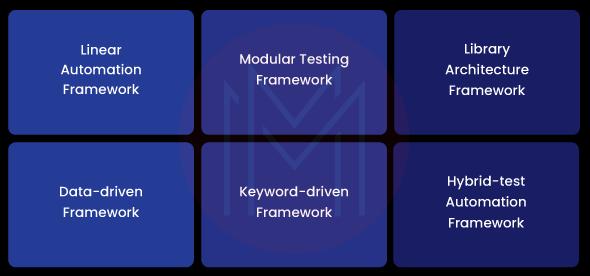
Next, we will discuss the frameworks one by one, along with their pros and cons in the way ahead.
1. Linear Automation Framework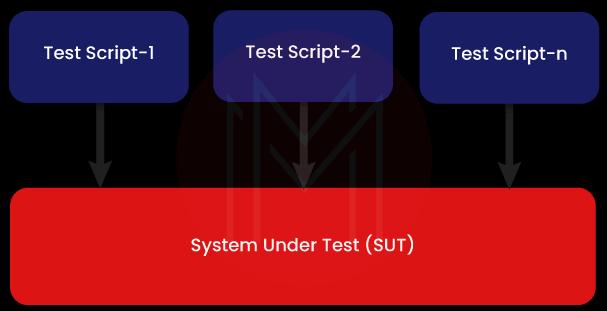
This framework is also named the ‘Record and Playback’ framework. It is one of the simplest automated testing frameworks. You can test small applications using this framework. For example, you can test web applications’ user interfaces. Mainly, this framework allows recording every step, such as navigation, checkpoints, user inputs, etc., and playback them in the following tests. That’s why this framework is named ‘Record and Playback’. Besides, testing is performed in sequential order.
Pros
- It requires only fewer codes and runs tests quickly. So, this framework will be beneficial to beginners. They can easily understand to use test methods, handle object repositories, and develop test scripts.
- By using this framework, you can test simple pages that don’t change their features frequently.
- It allows running simple applications.
Cons
- It requires additional efforts for maintenance.
- Any slight change in codes will lead to test failures, undoubtedly.
| Related Article: Automation Anywhere Tutorial |
2. Modular-based Testing Framework
This framework allows breaking the entire source code base into pieces. The pieces of code are known as modules. Essentially, these modules are nothing but test cases. You can create test scripts for every module application and store them in the function library. After that, you can test the modules separately. Also, it is simple to combine the codes together to conduct more extensive tests based on the hierarchical method. In short, you can decompose the code base into modules, and at the same time, you can recombine them again for performing more extensive tests.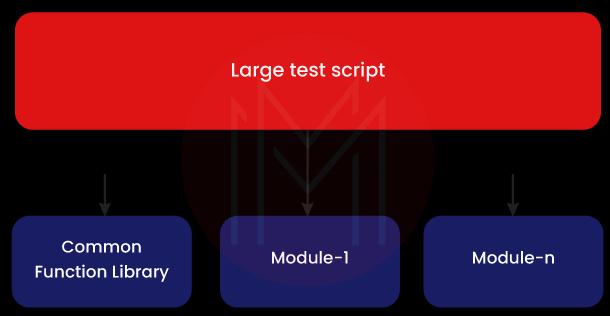
It is essential to note that this framework creates an abstraction layer that isolates the modules. Simply put, abstraction is the underlying concept of this framework.
Pros
- It allows for writing independent test scripts.
- Changes made in one module won’t affect other modules. So, maintenance is easy and offers good scalability.
- You can use both incremental and non-incremental approaches to test codes.
- It has reusable functions and follows a hierarchical approach.
Cons
- A deep understanding of the code base is required to identify reusable test scripts.
- Test data is embedded with source code – most of the time. In short, Test data is hard-coded.
3. Library Architecture Framework
This framework is known as the ‘Structured Scripting’ or 'Functional Decomposition' framework. This framework is similar to modular testing, but only similar tasks are grouped together. In other words, similar tasks are grouped by functions and stored in a shared library. Test scripts can call the functions from the library whenever they require it.
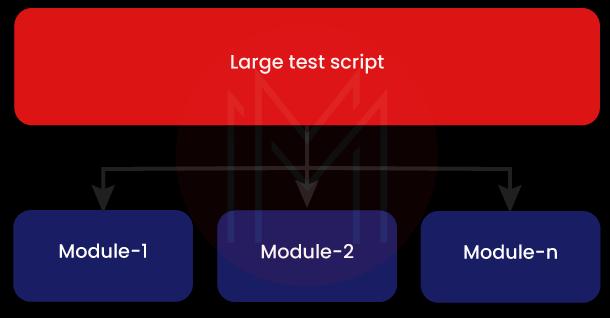
The wonderful thing about this framework is that it comes with high reusability. This is because functions are stored in a shared library. So they can be used by multiple applications at any time.
Pros
- Reusability, scalability, and maintenance are good.
- This approach is a cost-effective one.
Cons
- No doubt, changes made in the hard-core data will change the test scripts.
- It demands high technical expertise and more time for testing.
4. Data-driven Framework

This framework is introduced to overcome the drawback of the modular framework. It means that test data is not hard-coded in this approach. In this framework, we can isolate test data and test scripts separately. In other words, we can separate ScriptLogic from the test data. No single data is embedded with test cases. This framework allows testing codes with multiple datasets. It eliminates the need to modify test scripts. We can store the test data in excel sheets, CSV files, text files, SQL tables, databases with JDBC drivers, ODBC sources, and so on. In this framework, test scripts access data externally consistently.
Pros
- It increases the speed of testing since multiple datasets are used. The datasets can be used by multiple applications simultaneously.
- You don’t need to deal with many test scripts while using this framework
- You can easily maintain test scripts and fix bugs in them.
Cons
- Much technical expertise is required for writing test scripts
- Setting up time is long
- Test data and test scripts are tied closely. No doubt change in test data will change the test script.
5. Keyword-Driven Framework
In a way, this framework is introduced to overcome the setbacks in a data-driven framework. It is also known as the ‘Table-driven testing’ framework. Mainly, it provides predefined actions and methods in the form of keywords. Keywords are usually stored in keyword tables. Examples of keywords are InputText, VerifyPropety, VerifyValue, and so on.
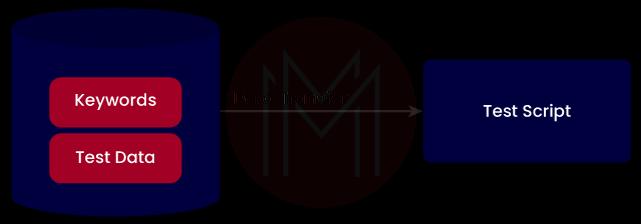
Moreover, keywords can be labeled as login, verifying, click, clicking, etc. Know that you can store keywords with their associated objects with the help of shared object repositories. Not only that, you can use these keywords in multiple scripts. You can use this framework for testing small applications.
Pros
- You can use Keywords across multiple test scripts
- You don’t need to have any technical expertise to work with this framework
- It has good scalability.
Cons
- Maintaining the keywords is not a simple task
- The cost of setting up this framework and the time needed are high.
- In a way, it is a complex framework. That's why test cases are also getting too complex.
6. Hybrid-test Automation Framework
A hybrid automation framework is yet another framework where we can combine one or more testing frameworks based on the software's complexity. This framework allows imbibing the pluses of other frameworks. Above all, you can use this framework across agile projects elaborately.
Pros
- It provides speed and cost-effectiveness.
- It improves testing efficiency.
Cons
- The combination of many frameworks increases complexity.
Benefits of the automated testing framework
There are plenty of excellent benefits that you can achieve by using automated testing frameworks.
Let’s have a look at them below. With automated testing frameworks, you can:
- increase the speed and accuracy of testing
- increase the reusability of codes for multiple applications
- reduce manual intervention
- reduce risks and security vulnerabilities
- optimize the use of resources
- increase the volume of testing
- conduct testing in parallel
- On top of all, it reduces time and costs.
Conclusion
To sum up, you must have walked through the different types of testing frameworks with their pluses and minuses. It is very crucial for testers to choose the correct framework to build efficient software. Also, they must choose the right automation tool that will best fit the chosen framework. Overall, automated testing frameworks simplify software testing as well as boost the efficiency of software.
 On-Job Support Service
On-Job Support Service
Online Work Support for your on-job roles.

Our work-support plans provide precise options as per your project tasks. Whether you are a newbie or an experienced professional seeking assistance in completing project tasks, we are here with the following plans to meet your custom needs:
- Pay Per Hour
- Pay Per Week
- Monthly
| Name | Dates | |
|---|---|---|
| Automation Anywhere Training | Dec 27 to Jan 11 | View Details |
| Automation Anywhere Training | Dec 30 to Jan 14 | View Details |
| Automation Anywhere Training | Jan 03 to Jan 18 | View Details |
| Automation Anywhere Training | Jan 06 to Jan 21 | View Details |

Madhuri is a Senior Content Creator at MindMajix. She has written about a range of different topics on various technologies, which include, Splunk, Tensorflow, Selenium, and CEH. She spends most of her time researching on technology, and startups. Connect with her via LinkedIn and Twitter .














